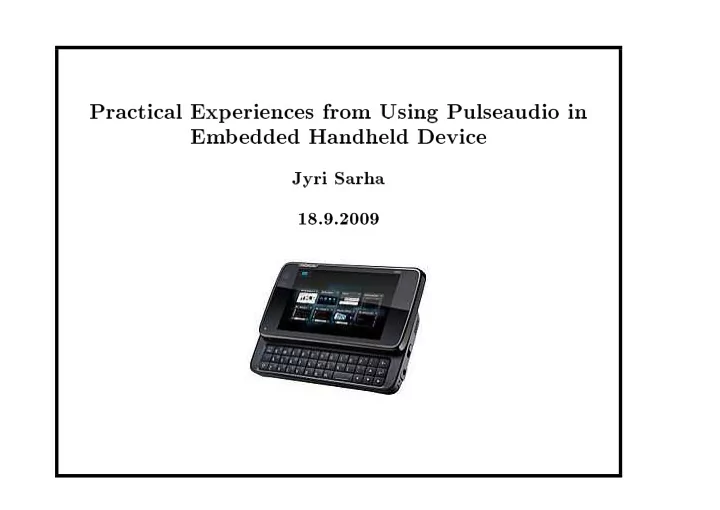

Practical Experiences from Using Pulseaudio in Embedded Handheld Device Jyri Sarha 18.9.2009
Practical experiences from using Pulseaudio in embedded handheld device, 18.9.2009 2 Background Information • Name: Jyri Sarha • Education: Master of Computer Science, Helsinki University of Technology 2000 • Employer: Nokia Devices / Maemo • Responsibility: Audio Subsystem Architecture and Development
Practical experiences from using Pulseaudio in embedded handheld device, 18.9.2009 3 Audio Features N900 Linux Phone • Runs Pulseaudio • Primary audio API is libpulse0 � Used mostly through gstreamer and libcanberra • Pulseuadio applies transducer speci�c audio processing and speech pre- and post-processing • Implements integrated VoIP and Cellular call functionality � All audio is played through Pulseaudio � IOW the phone has APE Centric Audio Architecture
Practical experiences from using Pulseaudio in embedded handheld device, 18.9.2009 4 Typical Smart Phone Audio Architecture • Cellular modem has direct connection to audio HW � Cellular call is power e�cient and easy to implement • Application Engine routes audio through cellular modem � Cellular modem wastes power in music playback use case • Add alternative audio route from APE to audio HW � HW design is complex and expensive � Audio routing, mixing and processing becomes complicated
Practical experiences from using Pulseaudio in embedded handheld device, 18.9.2009 5 What is APE Centric Audio Architecture • Audio HW connected directly Application Engine • Cellular call audio is routed via APE like any other application • Cellular modem becomes more like data modem
Practical experiences from using Pulseaudio in embedded handheld device, 18.9.2009 6 Advantages & Challenges of APE Centric AA • Advantages � All audio routing and mixing can be done in APE � Similar architecture to PC or laptop � VoIP and CS-call can share same audio processing pipeline � Conclusion: Simpli�es SW � Fewer functional requirements for Cellular modem � Less wiring on HW layout � Conclusion: Simpli�es HW • Challenges � Cellular call latency � CS-call audio processing consumes APE CPU � Both Cellular Modem and APE cosume power during call
Practical experiences from using Pulseaudio in embedded handheld device, 18.9.2009 7 N900 Audio HW Simpli�ed picture of N900 audio HW
Practical experiences from using Pulseaudio in embedded handheld device, 18.9.2009 8 Implementation Challenges • Minimize cellular call latency increase caused by the architecture • Audio pipeline optimization to minimize power and CPU consumption • Accurate feedback loop timing for Acoustic Echo Cancellation
Practical experiences from using Pulseaudio in embedded handheld device, 18.9.2009 9 Cellular Call Latency Challenge • Cellular modem air interface alone causes a lot of latency • GSM and 3G audio frame size is 20 ms • Cellular frame timing is ruled by base station • Timing of 20ms frames change in cellular hand over • Simple bu�ering between cellular modem and audio codec adds at least 20 ms latency to each direction
Practical experiences from using Pulseaudio in embedded handheld device, 18.9.2009 10 Minimize Cellular Call Latency • Run ALSA with two 5 ms fragments � This is doable even on ARM Linux with real-time priority � DMA bu�ering delay is 5ms each direction • Synchronize up link audio bu�ering with Cellular Modem � Cellular Modem sends up-link timing adjustment messages � Align up-link bu�ering according to messages � Change UL timing with 5 ms granularity • Synchronize down link audio bu�ering with Cellular Modem � Keep tight bu�er management to minimize latency
Practical experiences from using Pulseaudio in embedded handheld device, 18.9.2009 11 Use Time Optimization • Do e�cient power management • Optimize CPU usage � Use NEON vectorization when applicable � Optimize all audio processing for APE CPU � Including: Speex SRC and Nokia proprietary algorithms
Practical experiences from using Pulseaudio in embedded handheld device, 18.9.2009 12 E�cient Power Management • Turn all possible power domains o� as often as possible • Take advantage of McBSP2 (Multi channel Bu�ered Serial Port) � Do block transfers to McBSP2 1280 word bu�er � Power whole CPU down between blocks including DMA � Use bigger fragments when not in CS-call
Practical experiences from using Pulseaudio in embedded handheld device, 18.9.2009 13 Acoustic Echo Cancellation the Basic Idea • Correlate echo reference from the mic input to �nd alignment • Filter echo reference out from the mic input • Good acoustic echo path modeling for transient signals is possible only with proper time alignment of the reference loop
Practical experiences from using Pulseaudio in embedded handheld device, 18.9.2009 14 Accurate feedback loop timing for AEC • Accurate playback and capture latencies are needed for time alignment of echo reference and mic signal • Latency functions of ALSA do not work well with DMA doing block transfers • Solution: Implement ALSA sink latency functions based on snd_pcm_htimestamp()
Practical experiences from using Pulseaudio in embedded handheld device, 18.9.2009 15 N900 Pulseaudio Con�guration
Practical experiences from using Pulseaudio in embedded handheld device, 18.9.2009 16 Thanks! • to Lennart Poettering for the invitation • to Kai Vehmanen, Kalervo Kontola and Seppo Ingalsuo for ideas and support • to Marc-Andr� Lureau for encouragement to come
Recommend
More recommend